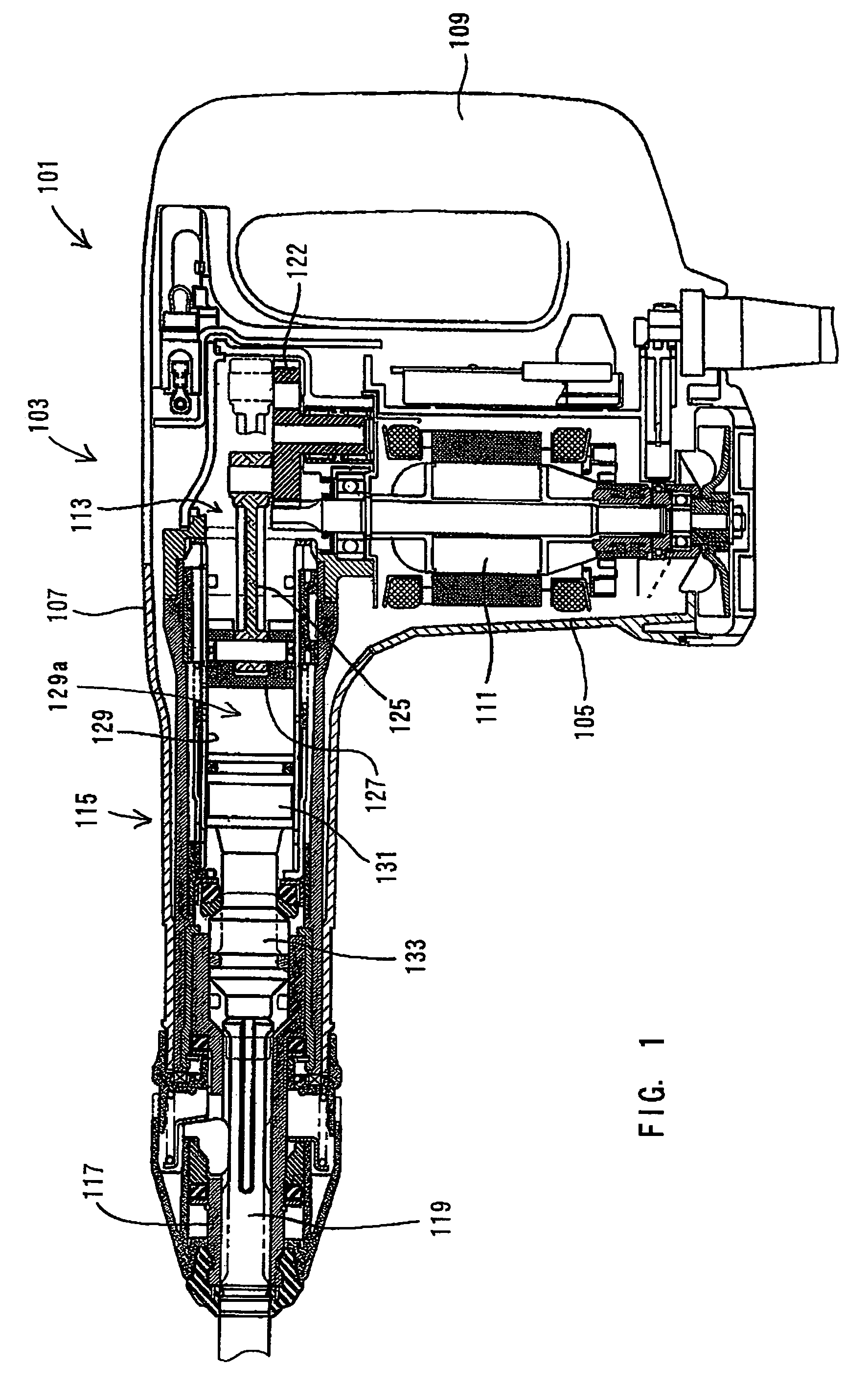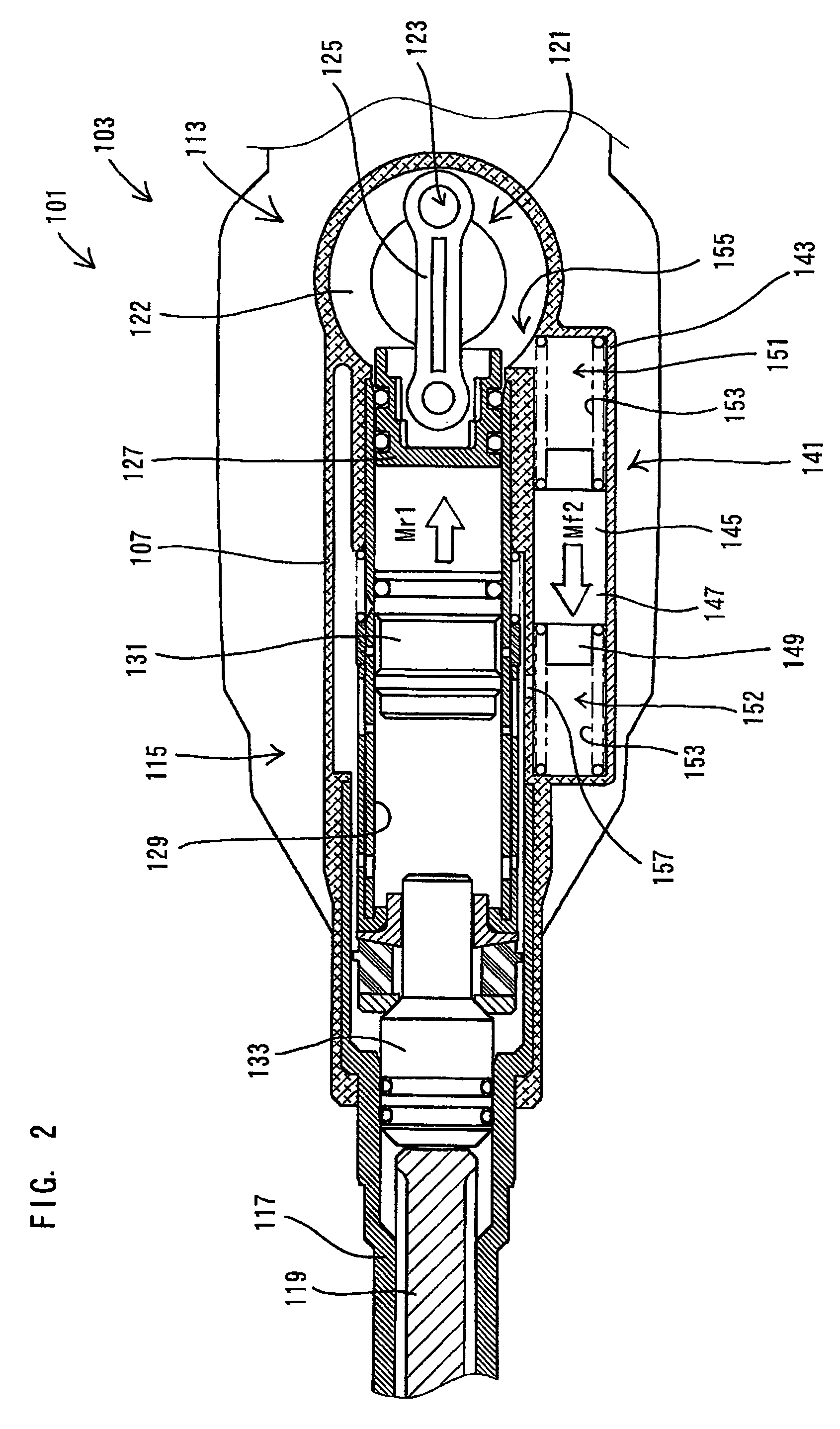Power tool
a technology of power tools and parts, applied in the field of power tools, can solve the problems of strong vibration in the axial direction of the hammer bit, and achieve the effects of reducing the number of parts of the power tool, preventing the weight from being driven, and simplifying construction
- Summary
- Abstract
- Description
- Claims
- Application Information
AI Technical Summary
Benefits of technology
Problems solved by technology
Method used
Image
Examples
first embodiment
[0043]A first embodiment of the present invention will now be described with reference to FIGS. 1 to 5. An electric hammer will be explained as a representative example of the power tool according to the present invention. As shown in FIG. 1, a representative electric hammer 101 according to this embodiment comprises a body 103, a tool holder 117 connected to the tip end region of the body 103, and a hammer bit 119 that is detachably coupled to the tool holder 117. The hammer bit 119 is a feature that corresponds to the “tool bit” according to the present invention.
[0044]The body 103 includes a motor housing 105 that houses a driving motor 111, a gear housing 107 that houses a motion converting mechanism 113 and a striking element 115, and a handgrip 109. The motion converting mechanism 113 is adapted to appropriately convert the rotating output of the driving motor 111 to linear motion and then to transmit it to the striking element 115. As a result, an impact force is generated in...
second embodiment
[0062]A second embodiment of the present invention will now be described with reference to FIGS. 6 and 7. In the second embodiment, a weight 245 of a dynamic vibration reducer 241 can be actively driven only under the loaded driving conditions in which a load is applied from the workpiece side to a hammer bit 219. For this purpose, a cylindrical actuating element 261 and a biasing spring 263 are fitted around a cylinder 229.
[0063]In FIG. 6, a hammer 201 is shown under the unloaded driving conditions in which no load is applied from the workpiece side to the hammer bit 219. At this time, the actuating element 261 is biased leftward as viewed in the drawing by the biasing spring 263. In this state, the actuating element 261 closes a first communicating portion 255 that communicates a first actuation chamber 251 of the dynamic vibration reducer 241 with the crank chamber 221. The actuating element 261 also closes a second communicating portion 257 that communicates a second actuation c...
third embodiment
[0068]A third embodiment of the present invention will now be described with reference to FIGS. 8 and 9. Like the second embodiment, the third embodiment is also constructed such that a weight 345 of a dynamic vibration reducer 341 can be actively driven only under the loaded driving conditions in which a load is applied from the workpiece side to a hammer bit 319. However, the third embodiment is different in construction from the second embodiment in the communicating state of a crank chamber 321 in the loaded and unloaded driving conditions. In a hammer 301 according to this embodiment, a cylindrical actuating element 361 and a biasing spring 363 are fitted around a cylinder 329. The crank chamber 221 is always in communication with a first actuation chamber 351 of the dynamic vibration reducer 341 via a first communicating portion 355.
[0069]In FIG. 8, the hammer 301 is shown under the unloaded driving conditions in which no load is applied from the side of the workpiece (not sho...
PUM
| Property | Measurement | Unit |
|---|---|---|
| pressure | aaaaa | aaaaa |
| weight | aaaaa | aaaaa |
| linear impact force | aaaaa | aaaaa |
Abstract
Description
Claims
Application Information
 Login to View More
Login to View More - R&D
- Intellectual Property
- Life Sciences
- Materials
- Tech Scout
- Unparalleled Data Quality
- Higher Quality Content
- 60% Fewer Hallucinations
Browse by: Latest US Patents, China's latest patents, Technical Efficacy Thesaurus, Application Domain, Technology Topic, Popular Technical Reports.
© 2025 PatSnap. All rights reserved.Legal|Privacy policy|Modern Slavery Act Transparency Statement|Sitemap|About US| Contact US: help@patsnap.com



